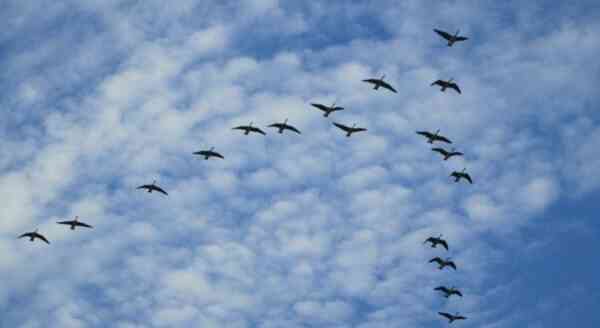Not all birds are migratory, some of them prefer to spend their lives in the same place. However, adverse climatic conditions force some birds to change their habitats from time to time, escaping from the lack of available food in winter. Such a way of life is probably not very simple, but nature certainly knew what she was doing when she adapted them for such long-distance flights.
Interesting facts about migratory birds
- In the process of migration they navigate by the Earth’s magnetic field so as not to go astray.
- Birds of the same species, but living in different regions, can lead both migratory and sedentary lifestyles (interesting facts about birds).
- Sometimes only part of the population is migratory. When winter sets in, blue jays, for example, partially fly south, but some individuals remain in place for the winter.
- Ornithologists have proven that migratory birds also orient themselves by the sun and stars, just like ancient navigators. And quite successfully.
- For reasons that are not fully understood, birds usually return from wintering much faster, maintaining a higher flight speed than when flying to warmer climes.
- Many birds fly in V-shaped flocks, since this shape reduces air resistance, making it easier flight.
- Ducks during flights usually maintain a speed of 100-120 kilometers per hour, and swifts even accelerate to 150-160 kilometers per hour.
- Not all migratory birds are migratory. Penguins, for example, migrate by swimming (interesting facts about penguins).
- Many migratory birds during their lives cover a distance comparable to the distance from the Earth to the Moon.
- Migratory birds return from wintering back, since the places where they fly for the winter are very popular among birds, and after 3-5 months the food for them ends there.
- Before a long journey, most migratory birds diligently eat off, gaining weight. These fat reserves will then be used up during the flight, as birds will rarely be distracted by food. Some of their species, before flying to wintering, gain a significant mass, becoming twice as fat.
- The longest migration routes are near Arctic terns. The officially recorded record of the flight of these birds to wintering was almost 22,000 kilometers. This is more than half the diameter of the earth’s equator.
- Migrating petrels travel an average of 25,000 kilometers per year.
- People have long noticed that some birds change their habitats at different times of the year. About 2300 years ago, Aristotle wrote about migratory birds (interesting facts about Aristotle).
- Geese rise above all during migration. They were noticed at an altitude of up to 9.1 kilometers. They can even fly over the Himalayas, the highest mountain range. Not all planes can reach such a height.
- Scientists have calculated that flying in the form of a wedge helps cranes and swans save up to 20% of the energy expended in flight.
- Migratory birds always find nests many thousands of kilometers away.
- Some migratory birds fly only at night, others only during the day, and some are able to fly around the clock, occasionally resting.
- Almost all birds make migratory flights as part of a flock, but there are also loners. True, there are few of them.
